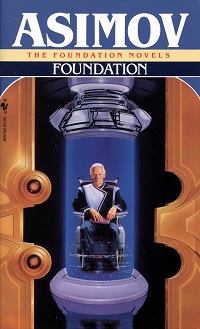In the first part of this series we began an exploration of the science portrayed in the first two parts of Isaac Asimov’s Foundation: the Psychohistorians and the Encyclopedists. Today we continue on with the third part of the book, the Mayors.
In my opinion, the third part of Foundation is considerably more dynamic and exciting than the first two parts. Most of you reading this probably know that the majority of the original Foundation book is actually a collection of short stories that were first published in Astounding Magazine back in the early 1940’s. (The first part of the book, the Psychohistorians, was added when the rest of the series was republished in book form).
The fact that these stories first appeared separately explains much of the writing style; particularly why key aspects of the plot that we already know about from the first parts of the book are explained again in subsequent parts (such as Hari Seldon’s plan and the situation of Terminus at the edge of the galaxy).
However Asimov doesn’t just rehash the same version of these plot points. He describes them in a way that shows that the characters’ interpretations of these things have changed over the years since the first parts of the book took place.
The Priesthood of Science
Throughout this story, we’re told that the key to Terminus’ survival so far can be attributed to its superior understanding of science and technology. While the four kingdoms surrounding Terminus have superior military might, they are indebted to the Foundation for providing them with things such as atomic power, sophisticated medicine, and even advanced weaponry. The only thing preventing the other kingdoms from taking over the Foundation is the fact that they don’t understand how any of this technology works.
While the Foundation has given the technology freely to everyone, they have done so in a way that shrouds the science behind the gifts “in the most outrageous mummery,” making a full-fledged religion out of the application of science.
Today we may laugh at the foolishness of those people so easily taken in by the Foundation, but if we look deeper, if we ask ourselves some pointed questions, you might begin to wonder, as I do, how far from reality this story really is.
At one point the mayor, Salvor Hardin, says of those that administer this technology in the outer kingdoms that “their knowledge of their tools is purely empirical;” So ask yourself this question: how many facets of science and technology does your life currently depend on that you have only an empirical knowledge of?
How many of us understand the inner workings of the technology and science behind the computers we use everyday to get our work done. How many of us understand how even ubiquitous pieces of technology like cellular phones work. How do the radio waves of cell phones differ from the microwaves we use to cook our food?
How many of us take medicine required for our survival, but whose biochemical effect on our bodies we are completely ignorant of? How many of us operate a vehicle of some sort without understanding anything about how its engine works or how to repair it should it break down?
While the peoples of the outer kingdoms might be excused because they almost all lacked the means to discover this information themselves, what excuse do we have when nearly the totality of all human knowledge is available to us for free in so many forms?
Newspaper and Paper Messages
I found it interesting that several times in Foundation we find people reading printed newspapers, sometime while flying between planets in sophisticated spacecraft. This is an interesting contrast to what many people consider to be the imminent fate of present-day newspapers.
Speaking of things in print, at one point in the story a confidential message is sent to Salvor Hardin on printed paper, with the key aspects of the message written in pencil. He conveniently destroys all traces of this message with an atomic disintegrator, something that must be an appealing thought to so many whose electronic communications seem to often be an embarrassment to them.
A few days ago I sat down with my children and explained to them how email worked, using Google’s fantastic The Story of Send animation to provide a visual aid. At one point one of my daughters said to me with wide eyes, “You mean all of those people might read our email?”
I reassured her that while it was pretty unlikely that anyone but the intended recipient was reading her email, the fact was that lots of people did have the potential to read the contents of those messages. Something that the government of the Foundation appears to understand better than other politicians we might think of.
Conclusion and Homework
Once again I leave you with homework, find some technology that you interact with, even if it is as simple as turning on a light switch or starting your car, and spend some time learning the principles behind how it works. If you learn something great, share your experience in the comments.
Dr. Lee Falin is a Bioinformatician at the European Bioinformatics Institute, the host of the Everyday Einstein’s Quick and Dirty Tips podcast and the author of the “Science Fictioned” series, in which he takes scientific research articles and turns them into science fiction and fantasy short stories for middle grade and young adult readers. You can follow him on twitter at @lfalin.










